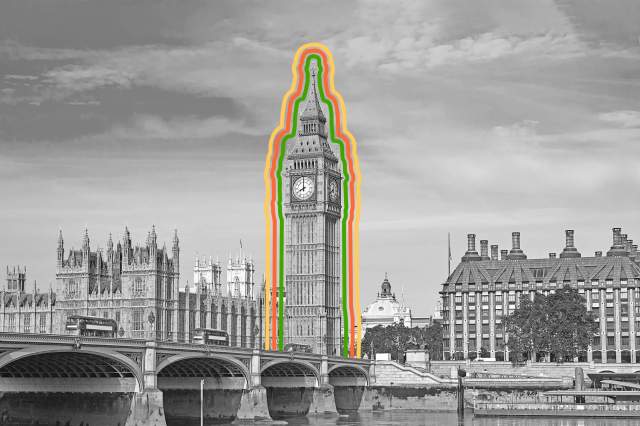
The Oldest Working Mechanical Clock Is Located at an English Cathedral
England’s Salisbury Cathedral dates back to the 13th century, and is home to one of four surviving original copies of the 1215 Magna Carta. The cathedral is also the site of the world’s oldest working mechanical clock, a machine dating back to 1386, if not earlier.
Composed of hand-wrought iron and intertwined with long ropes that extend halfway up the cathedral walls, the Salisbury Cathedral clock is the brainchild of three clockmakers: Johannes and Williemus Vriemand, as well as Johannes Jietuijt of Delft. The clock operates thanks to a system of falling weights, which are pre-wound once each day, and the device is designed solely to denote each passing hour. It once sat in a detached bell tower before falling into disuse around 1884. Thankfully, the mechanism was rediscovered in 1929 and later restored in 1956; prior to that restoration, the clock had successfully chimed for nearly 500 years on over 500 million separate occasions. It continues to operate today.

Pennies Are Used To Maintain the Accuracy of Big Ben’s Clock Tower
London’s Elizabeth Tower, at the north end of the Palace of Westminster, boasts one of the most recognizable clock faces in the world. Inside the tower’s belfry is where one can find “Big Ben” — though many use the name to refer to the tower as a whole, it actually refers to the mechanism’s grandest and most prominent bell. Name-related confusion aside, the clock is notable for another reason, too: Its accuracy is regulated using old pennies and, on occasion, other coins.
Due to external atmospheric conditions such as air pressure and wind, the exact time depicted on the face of Elizabeth Tower can fall ever so slightly out of sync with reality. In order to right these wrongs, old pennies — coins that existed prior to England’s switch to decimal coinage in 1971 — are added to the bell’s pendulum, which in turn alters the daily clock speed by 0.4 seconds per penny. The process is a long-standing one, having been used to regulate the time as far back as 1859. In 2012, three of the 10 coins relied upon for this purpose were, for a brief time, swapped out for a five-pound crown commemorating that year’s London Olympics.

19th-Century Maritime Signals Inspired Times Square’s New Year’s Ball
The New Year’s Ball drop in Times Square, New York, is a beloved annual tradition, though its origins had nothing to do with revelry. In fact, the ball drop was inspired by a 19th-century timekeeping mechanism targeted at maritime crews. “Time balls” — which dropped at certain times as a signal to passing ships and navigators to set their on-ship chronometers — first appeared in Portsmouth Harbor in 1829 and later at England’s Royal Observatory at Greenwich in 1833. In fact, the giant red time ball located in Greenwich continues to operate today.
The balls were the culmination of an idea suggested by a man known as Robert Wauchope, who promoted the concept of visual clues located ashore to help passing ships tell time. Wauchope originally suggested the use of flags, though orbs that moved up and down were finally settled upon instead. Though these time balls were initially made to help mariners keep track of time, they soon became an attraction among locals, as people would come to watch the ball fall, in a precursor to today’s New Year’s Eve crowds.
More Interesting Reads

Medieval Engineer Ismael al-Jazari Invented an Elephant Clock
Throughout the 12th and early 13th centuries, few inventors pioneered more mechanisms in the world of robotics than Ismael al-Jazari, who lived and worked in what is now Turkey. Al-Jazari was so influential at the time that he’s believed to have even inspired the works of Leonardo da Vinci. Among al-Jazari’s most notable timekeeping inventions was an elephant clock, colorful illustrations of which appeared in his 1206 manuscript, The Book of Knowledge of Ingenious Mechanical Devices.
The clock was an intricate device constructed atop the back of a copper elephant, containing several moving parts as well as a scribe to denote the passing of time. The entire clock relied upon a water-powered timer, which was made up of a bowl that slowly descended into a hidden tank of water. As that bowl sank, the scribe noted the number of minutes. Furthermore, every half hour a ball would be triggered to fall and collide with a fan, which rotated the device’s dial to show how many minutes had passed since sunrise. That same ball ultimately dropped into a vase that in turn triggered a cymbal to begin the cycle anew. The whole mechanism not only incorporated this Indian-inspired timing technology, but also Greek hydraulics as well as design elements from Egyptian, Chinese, and Arabian cultures.

The World’s Most Accurate Clock Is Located in Boulder, Colorado
Located in the basement of a laboratory at the University of Colorado, Boulder, is a clock considered to be the world’s most accurate. Invented by scientist Jun Ye, the clock is so precise that it would take 15 billion years for it to lose a single second of time. That absurd number dwarfs the traditional 100 million years that it takes many modern atomic clocks to lose a second.
The first atomic clock was constructed in 1949 by the National Bureau of Standards, and helped scientists to accurately redefine the measurement of a second by the year 1967. Prior to that point, a second had been calculated as 0.000,011,574 of a mean solar day, which proved to be inaccurate due to the irregular rotation of the Earth. Ye’s new clock optimizes the techniques of those early atomic clocks, using strontium atoms that are arranged in a 3D lattice to tick at 1 million billion times per second. While that science-heavy explanation may not be entirely clear to the average person, Ye’s atomic clock can be summed up like this: It’s really, really accurate.

French Revolutionary Time Instituted a System of 10-Hour Days
While societies around the world may not agree on much, one thing that’s generally accepted is that each day is 24 hours long. Back in 1793, however, during the French Revolution, France took an oppositional stance and adopted a new timekeeping concept. This decimal time concept included 10-hour days, 100 minutes every hour, and 100 seconds per minute. In essence, its base 10 method of timekeeping was proposed as a simpler way to note how much time had passed on any given day.
This new timekeeping plan officially started on November 24, 1793, and was immediately met with resistance and confusion by the public. People were unwilling to change their old habits for telling time, despite French clockmakers producing new mechanisms that featured both traditional timekeeping methods and the new decimal-based technique. In the end, decimal clocks lost their official status in 1795, though the concept wasn’t quite dead yet. France tried yet again in 1897, this time proposing a variant that incorporated 24-hour-long days with 100 minutes per hour, but that proposal was scrapped in 1900.












